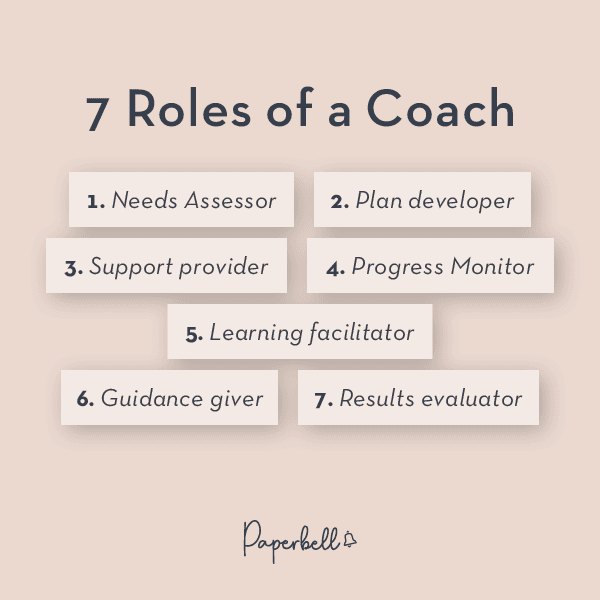Being a coach is far from simple. Sometimes it can feel like you’re a strategist, parent, best friend, therapist, and project manager all in one.
Navigating all these different roles is no picnic. However, to go from “good” to “great” as a coach, understanding and embodying these roles is key.
So what exactly are these roles and how can you best show up in each one to create transformation for your clients? Keep reading to discover.
The 7 Most Crucial Roles of a Coach

As a life coach, your role is more than just giving advice; you’re there to steer clients toward building the skills and knowledge necessary to make their own well-informed choices confidently.
That requires you to play multiple important roles in your relationship with them. Here’s what they typically are.
1. Setting and Achieving Goals
If you help your client articulate clear, achievable goals, it will be much easier to achieve them.
Start with assessing your client’s needs. Delve deeper than understanding what they want and get to the root of why they have those aspirations.
Then, analyze their strengths and weaknesses. Doing this will tell you where they need to improve and what existing skills they can build upon.
As you start working toward those goals, look at potential obstacles. These may be external factors, like lack of resources, or internal ones, such as fear or self-doubt. Identifying them helps your client come up with strategies to overcome them. A goal tracking app will also help with setting and achieving goals.
2. Developing Plans
A crucial part of coaching is developing personalized plans tailored to each client. Mastering this role will let you make adjustments as a client’s circumstances change.
As always, the coaching process starts with identifying clear goals for your client and then crafting a plan to help them get there.
Staying flexible and adjusting the plan as needed is important even if you run a structured coaching program. This allows you to listen to changing needs and situations.
For example, I typically send a daily email newsletter to my clients, but this cadence doesn’t work for all of them. Sometimes, I need to find an alternative approach that will yield the best results for my client.
3. Providing Support
It may change from client to client what support they need from you and what coaching style they best respond to. It also depends on your training—it’s okay to know your limitations and not offer the type of support you’re not qualified to give.
One of the most common types of support coaching clients look for is emotional support.
For example, they may fear taking the necessary action to reach their goals. My clients are often afraid of sending too many emails to their subscribers, even though those people opted in for regular newsletters and have the option to unsubscribe. So, in cases like this, it’s not a matter of changing the strategy but addressing your client’s emotions.
Another way you can assist your clients is through motivational support.
An encouraging environment pushes them to strive harder despite difficulties. Research shows that motivated individuals deliver better results, which is one of the biggest reasons why people hire coaches in the first place.
4. Monitoring Progress
Tracking your client’s progress allows you to evaluate the effectiveness of your coaching approach and make necessary adjustments. This way, you can identify previously unseen obstacles and proactively manage them.
Some coaching tools for monitoring progress are journaling exercises, goal-setting apps, and specific metrics tailored to your client’s objectives.
You can also establish a cadence for check-ins to ensure nothing falls through the cracks between sessions. For example, you can automate an email with a survey to prompt clients to record their progress.
5. Facilitating Learning
To help clients gain new insights and change behavior, you can use problem-solving exercises or brainstorming sessions to facilitate their learning.
Role-playing has been widely recognized as an effective method for coaching. This technique allows clients to practice handling difficult social situations within a safe environment before facing them in real life.
When I went through sales coaching, role-playing sales conversations helped deepen the learning experience more than theoretical sessions alone.
6. Giving Guidance
As a coach, you may offer advice on how to best develop skills or make smart decisions, depending on your methodology.
For example, you can teach your clients effective communication techniques, such as:
- Active listening
- Using “I” statements
- Understanding non-verbal cues
If you want to help them make better decisions, you may use decision-making frameworks that structure their thinking process or brainstorm the potential consequences of each option they can choose.
7. Evaluating Results
Life coaches need to evaluate the effectiveness of their sessions to keep clients on track. This is different from monitoring their client’s progress; it’s about making sure their approach gets them where they want to be.
One way to do it is through client surveys. Interview your clients on what they found helpful in sessions and what they didn’t, as well as the changes they experienced so far as a result of your work together.
When your clients reach the goals they set, you can help them figure out what’s next. Whether or not they continue working with you, leave them well-equipped to face the next part of their journey.
What’s Outside of the Role of a Life Coach?
You’ll wear many hats as a coach, but that doesn’t mean you should be everything for everyone.
So what falls outside of the role of a coach?
Firstly, a coach is not a therapist or a psychologist. Unless you’re specifically trained in these professions, it’s not your job to help clients heal from past trauma or diagnose mental health issues.

Image source: meetmonarch.com
Besides training, the key distinction is that therapists focus on helping patients overcome their past, while coaches support clients as they move toward the future they want to have.
In the same train of thought, any role that falls outside your expertise is a role you shouldn’t adopt as a coach.
For example, let’s say you’re a relationship coach but have no experience or training in helping clients through divorce. If a client wants to focus on this area of their life, it may serve them better if another specialized coach steps in.
Finally, any role that makes you uncomfortable or falls outside your boundaries is a role you should avoid.
While some coaches love to get friendly and casual with their clients, other coaches don’t like this approach. It’s up to you to establish what boundaries you’re comfortable with.
Build an Effective Coaching Practice
Embodying these key roles can make all the difference in your coaching. Each of them allows you to serve your clients more effectively and guide them toward lasting transformation.
To streamline your business and focus more on coaching, why not let Paperbell handle the admin work?
With Paperbell, you can set up a fully optimized coaching website in a few clicks. Then you can manage your clients through one neat system with scheduling, payments, contracts, surveys, and all client information baked into it.
Try Paperbell with your first client for free.

Editor’s Note: This post was originally published in August 2023 and has since been updated for accuracy.









